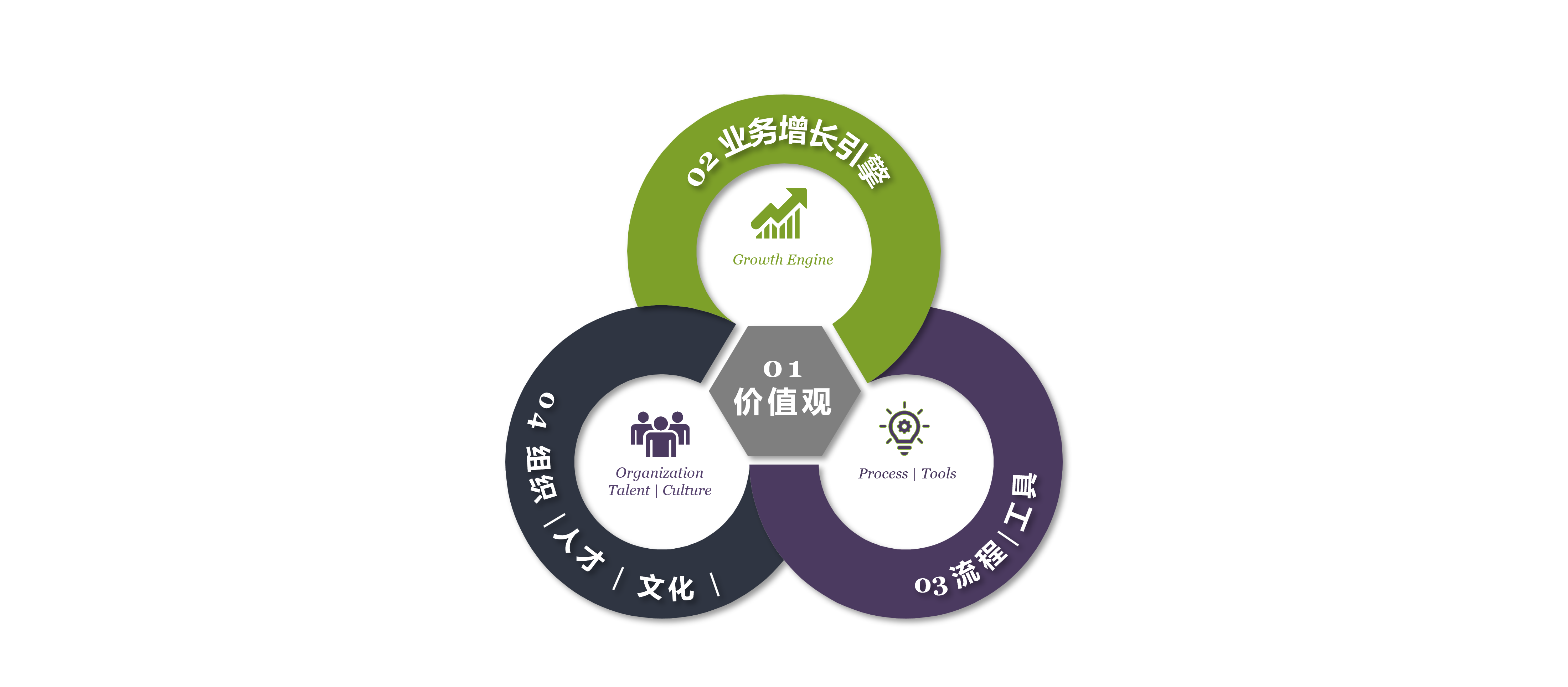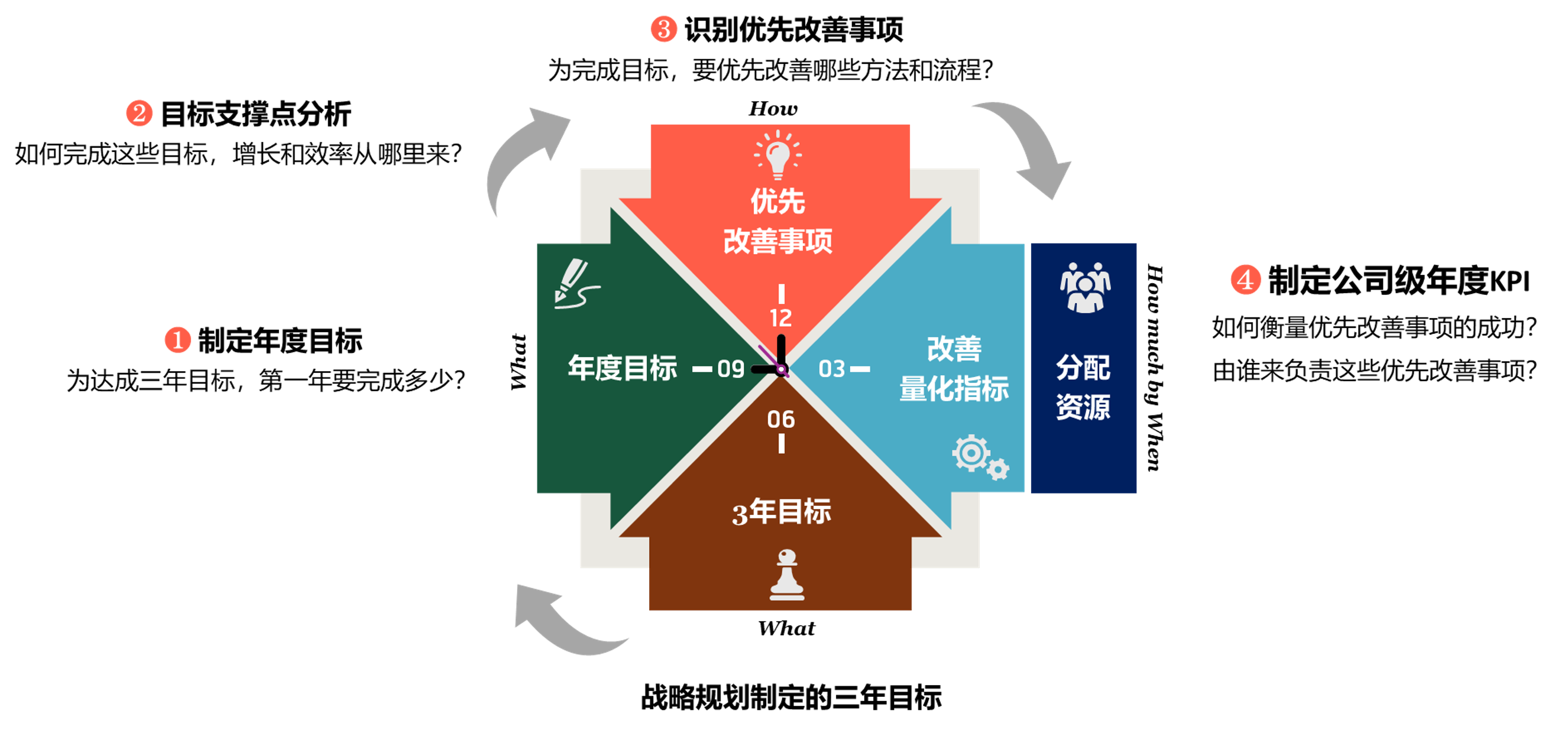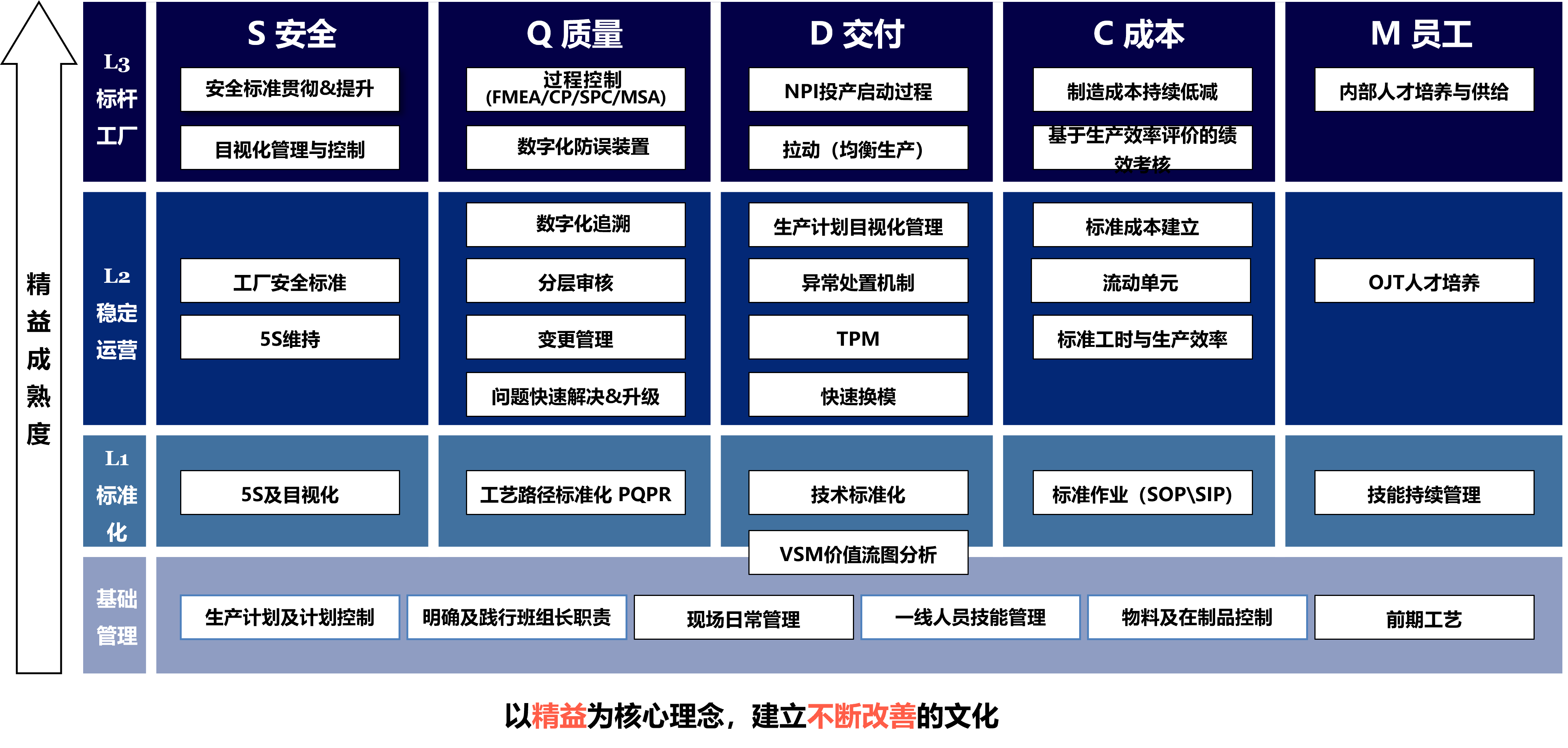
我们的方法论
Our Approach
we help our clients grow, solve big operational problems. We change the way our clients think about how they do their work.
And we consistently deliver results.

Business System
赋能式经营系统的目的,是帮助企业成长。它由价值观、业务增长引擎、流程&工具、组织人才文化四个部分组成。企业如何才能增长、用什么方式增长,答案就在经营系统中。
价值观,是做事的理念和是非判断,要做什么、不做什么。价值观是凝聚组织成员,穿透前途迷雾的手电筒。
业务增长引擎,是企业增长的模式。每个企业都有自诞生起自带的基因。因此,注定了每个企业的增长方式不同。找到驱动企业不断增长的业务增长引擎,形成自己的业务飞轮闭环,才能不断突破成长。
流程&工具,是实现增长的看得见摸得着的抓手。企业要以核心经营能力为定海神针。但是,只有把这种能力以工具的形式封装起来,才能迅速地在组织内部复制成功、提升组织能力,并在拓展过程中向外赋能。
组织人才文化,是实现增长的土壤。没有优秀的团队和文化,再好增长引擎和核心能力,都无法扎根、发芽和结果。
The purpose of a business system is to help companies grow. It consists of four components: Values, Business Growth Engine, Processes & Tools, and Organization, Talent & Culture. How a company can grow, and in what way it grows, lies within the business system.
Values represent the principles and judgments that guide decision-making—what to do and what not to do. Values are like a flashlight, gathering the members of the organization and illuminating the path forward through uncertainty.
The Business Growth Engine is the company’s growth model. Every company has its unique "genes" from the moment it is founded, which determines that each company’s growth method will be different. Finding the right engine that drives continuous growth and forming a self-reinforcing growth loop is the key to breaking through and achieving sustained growth.
Processes & Tools are the tangible means of achieving growth. The company’s core operational capabilities should be the guiding force. However, only by encapsulating these capabilities into tools can they be quickly replicated within the organization, enhancing overall capabilities and enabling external empowerment during M&A.
Organization, Talent & Culture are the soil in which growth takes root. Without a strong team and culture, even the best growth engines and core capabilities cannot take root, sprout, and bear fruit.

丹研会倡导“干中学”的理念,为每一个企业量身订制搭建自己的经营体系的同时,解决问题,提升业绩,提升组织能力。
We facilitates a “learn-by-doing” approach through implementation of Business System model tailored to a client’s specific needs. This builds a top-talent organization, driving near-term results improvement, and ongoing sustainable competitive advantage.
我们结合国内中小企业发展现状,对标世界级企业,提出了九大核心能力指标。为中小企业在发展的路上指明方向。
We introduce nine core competency indicators by considering the statues of domestic small-to-medium-sized companies and benchmarking against world-class companies. This aims to provide guidance for small-to-medium-sized companies as they progress in their growth journey.

我们将企业的成长划分为四个阶段,从达成“可预见的”业绩增长,到拥有“对外赋能”能力。企业的稳定的业绩增长,始于对细分市场的客户需求的深度洞察、以及基于客户需求的产品创新。同时,一整套成熟的管理工具能够帮助企业快速建立日常管理的能力。最后,企业的增长一定是建立在强大的组织人才能力、和不断改善的企业文化的土壤之上。
因此,丹研会的赋能式经营体系与其他经营体系的最大区别在于,它不仅仅是一套“管理工具”,而是一套贯穿战略、管理工具、组织能力和企业文化的完整体系。
We divide the growth of companies into four stages, ranging from achieving "predictable" performance growth to possessing "enabling" capabilities for external impact. The stable performance growth of the company begins with a deep understanding of customer needs in the segmented market and product innovations based on those needs. Simultaneously, a comprehensive set of mature management tools can help the company rapidly establish its day-to-day operational capabilities. Finally, the growth of the enterprise must be built on a strong foundation of organizational talent and continuously improving corporate culture.
Therefore, the most significant difference between our enabling operational system and other management systems is that it is not just a set of "management tools" but a complete system that integrates strategy, management tools, organizational capabilities, and corporate culture.

Strategy Planning
选好赛道,聚焦增长;团队同频;建立数据说话、目标驱动的组织氛围,是丹研会战略三部曲的核心
丹研会的“战略三部曲”,包含战略规划、战略部署和战略执行三个部分。
"The Strategic Trilogy" comprises three components: strategic planning, strategic deployment, and strategic execution.

战略规划
“一米宽,一百米深”。帮助中小企业找到独特的细分市场,满足特定客户群体需求、打造能力、实现稳定的内生增长,成为细分市场中的“隐形冠军”,是丹研会战略规划的核心。
对绝大部分快速成长中的企业来讲,选择“大”市场还是“细分”市场,是个方向性问题。在细分市场中,做“头部客户”还是做“尾部客户”,同样是方向性问题。如何在细分市场中看清头部客户、了解头部客户的需求,并在产品创新、卓越运营能力上持续进步,满足头部客户的需求,是个方法问题。
丹研会通过多年经验和深度了解国内制造业企业情况,帮助企业聚焦细分市场(赛道),并将方向性的决策转化为可衡量的目标、可落地的举措。
细分市场机会全景图是丹研会战略规划的关键工具,通过四个维度的全景图,将细分市场层层剥开,最终转化为可落地的市场销售目标。
“One meter wide, one hundred meters deep." Helping companies find unique niche markets, meet the specific needs of customer segments, build capabilities, achieve stable organic growth, and become "invisible champions" in their respective niches is the core of our strategic planning.
For a fast-growing companies, choosing between the "large" market and the "niche" market is a directional issue. Within the niche market, deciding whether to focus on "head" customers or "tail" customers is also a directional issue. Understanding and grasping customers’ needs, continuously improving product innovation and operational excellence to meet their demands, are core capabilities .
Through years of experience and in-depth understanding of the domestic manufacturing industry, we help companies focus on niche markets and transforms directional decisions into measurable objectives and actionable strategic initiatives.
MEKKO chart is a powerful tool used during strategic planning. Through four MEKKO charts, systematically peels back the layers of the niche market, ultimately transforming it into achievable market sales targets.

战略部署
“说到、做到”是优秀企业的最大特质。大多数企业的战略规划不能落地的原因,在于对于战略部署环节的缺失。战略部署主要解决顶层战略方向和中基层团队工作之间的断层问题,让团队充分同频。将公司的中长期战略目标与部门和个人的短期工作任务有效链接。
在战略部署时,我们将(1)把企业的三年目标,转化为有挑战性的一年目标;(2)帮助团队聚焦,将有限的资源分配到“关键少数”改善事项上;(3)将关键少数改善事项落实到具体负责人、并设立可量化衡量的绩效指标。
丹研会战略部署使用的关键工具 – X矩阵,是一个适用于期望高增长、设定挑战性目标的企业的战略工具。
“Walk the talk” is the greatest characteristic of a companies. Many companies fail delivering the performance potential identified in the strategic plan. This Strategy-to-Performance Gap is caused by inadequate resourcing, ineffective communication of the strategy, poorly defined accountability, and limited performance monitoring.
During the strategic deployment, we will (1) translate the three-year goals of the company into challenging one-year objectives; (2) assist the teams in focusing and allocating limited resources to a "critical few" improvement areas; (3) implement these critical few improvement areas with specific responsible individuals and establish measurable performance indicators.

战略执行
有效的战略执行始于战略分解,即将公司的战略目标转化为部门和关键岗位的目标,将公司的关键少数改善事项转化为团队的行动计划。然后,围绕绩效指标不断进行月度点检,并使用PSP(问题解决流程)对差距进行分析、制定措施。
Effective strategic execution begins with strategic decomposition, which involves translating the company's strategic objectives into departmental and key position-specific goals, and converting critical few improvement items into team action plans. Subsequently, monthly performance reviews are conducted around key performance indicators, and gap analysis is carried out using the PSP (Problem Solving Process) to formulate corrective measures.

Product Development
“创新定义未来”,不断创新,开发出满足客户需求、质量稳定的产品,是企业的终级竞争力。
我们看到很多企业面临两类典型的痛点问题。第一类是,投入了大量的人财物、立了大量的项目,却均已失败告终,没有开发出拿得回订单的产品。第二类是,新产品、新技术储备不足,没有足够的项目。不论是哪一类问题,最终结果都是不能满足客户需求、不能支撑销售的增长,逐渐丢掉市场份额。
丹研会的产品开发体系旨在通过系统性的管理工具帮助本土制造业企业解决面临的问题。
“端到端”的完整体系
丹研会的产品开发体系不仅仅包含传统意义上研发部门负责的‘产品设计’,而是从企业战略规划出发,从“找到正确的产品”,到“开发出好的产品”,到产品的上市、以及产品优化迭代的全流程。
关注产品开发的“商业价值”
✔ 做高毛利的产品 - 充分了解竞品,做好产品差异化和定价策略。并全方位关注料、工、费成本。
✔ 做能卖得动的产品 - 聚焦细分市场及客户需求。充分验证产品可靠性、保证质量稳定性。
✔ 降低研发“成本”- 降低研发投入巨大,却没有产出的“沉默成本”。降低产品不好、时间太长,错失市场机会的“机会成本”。降低性能、质量不达标,客户流失的“隐形成本”。
"Innovation shapes the future." Continuously innovating and developing products that meet customer demands with consistent quality is the ultimate competitive advantage for any company.
We observe two typical pain points faced by many companies. The first type is characterized by investing significant resources, and funding into numerous projects that ultimately end in failure, resulting in the inability to develop products that generate orders. The second type is characterized by lack of products to capture the market and improve gross margins. Regardless of the type of problem, the ultimate outcome is the failure to meet customer demands and support sales growth, leading to a gradual loss of market share.
Our product development system aims to help local manufacturing companies address these challenges through a systematic set of management tools.
An "end-to-end" comprehensive system
Our product development system goes beyond the traditional sense of "product design" handled by the R&D department. It encompasses the entire process, starting from enterprise strategic planning, finding the right products, developing high-quality products, product launch, and continuous product optimization and iteration.
Focus on the "business value" of product development
Develop high-margin products - Thoroughly understand competitors, implement effective product differentiation and pricing strategies, and comprehensively manage material, labor, and overhead costs.
Create marketable products - Concentrate on segmented markets and customer needs, rigorously validate product reliability, and ensure stable product quality.
Reduce "costs" of development - Minimize the "silent costs" of large R&D investments that yield no results. Avoid the "opportunity costs" of developing products that are not well-received or take too long, missing market opportunities. Eliminate the "hidden costs" of customer attrition due to subpar performance or quality.


Commercial Excellence
大客户战略是丹研会营销管理的核心。
做细分市场的头部客户。通过满足头部客户的需求,不断提高自身能力,不断提升市占率。成为细分市场的领军企业。
丹研会的营销体系强调“团队作战”。将“武林高手”的个人能力,转化为可学习、可复制的团队能力。
丹研会的营销体系强调“抓重心”。抓重点客户、抓重点销售机会。将工作重心和资源向核心客户倾斜,不撒胡椒面。做好客户的分级分类是销售业绩能否达成的先决条件。
丹研会的营销体系强调“价值销售”,通过深度了解客户、洞察客户需求,不断提升价格实现率、提升毛利。
Key Account Management is at the core of our commercial excellence.
Focus on the top customers in segmented markets. By meeting the needs of these top customers, continuously improve capabilities and increase market share. The goal is to become the leading company in segmented markets.
We also emphasizes "teamwork." Transform the individual capabilities of "martial arts masters" into learnable and replicable team abilities through systematic and tool-based management.
Our marketing system also emphasizes "prioritization." Prioritize key customers and key sales opportunities. Direct efforts and resources towards key customers. Properly classifying and grading customers is a prerequisite for achieving sales performance.
Simultaneously, a deep understanding of customers, insight into their needs, and value-based selling are the core principles also.


Lean Transformation
丹研会的运营管理包含生产、质量和供应链三大模块。紧紧围绕Q(质量)D(交付)C(成本)目标,不断降本增效、提升质量。
Our operations management comprises three major modules: production, quality, and supply chain. It revolves around the Q (Quality), D (Delivery), and C (Cost) objectives, consistently aiming to reduce costs, enhance efficiency, and improve quality.
精益是丹研会生产管理的核心。精益生产要紧紧围绕战略目标的达成为原点,工作有目标,进步可衡量。通过目视化充分暴露问题,并建立不断改善的文化。
Lean is at the core of our production management system. Lean production is centered around achieving strategic objectives, with work being goal-oriented and progress measurable. It involves visualizing problems, fostering a culture of continuous improvement.


Talent Management
“什么事说到底都是人的事”。这句话反映出很多企业在现实中的痛点。再聚焦的战略、再好的工具方法,如果没有好的团队,都很难落地。建立起优秀的团队,是企业发展过程中的必经之路。
人力资源工作剧本是帮助企业从组织、绩效、薪酬和激励、人才及经营体系赋能五大模块建立人力资源的基础架构。并围绕着目标实现,持续整合和优化各个模块,帮助企业提升组织能力,打造一支能够在内部引领组织迎接挑战、在外部赋能其他组织的人才梯队的指导手册。
"Ultimately, everything comes down to people." This statement reflects the pain points many companies face in reality. No matter how focused the strategy or how excellent the tools and methods are, without a strong team, it is difficult to implement them effectively. Building an outstanding team is a necessary step in a company’s development journey.The Human Resources Playbook helps companies establish a foundational HR framework through five key modules: Organization, Performance, Compensation and Incentives, Talent, and Business System Empowerment. It focuses on achieving goals by continuously integrating and optimizing these modules, serving as a guide to help companies enhance organizational capabilities and build a talent pipeline capable of leading the organization to meet challenges internally and empowering other organizations externally.


Finance
财务工作剧本聚焦于制程企业持续增长相匹配的财务能力的提升,让财务作为业务伙伴服务企业经营,避免业务财务两层皮。
工作剧本分为六个部分:财务核算、内部控制、业财融合、目视化信息化、集团管理、以及团队成长。
财务核算:核算是财务的根基,没有和企业现状匹配、符合财务原则的核算规则,最基本的分录不能反映业务实质,一切分析、所有漂亮的仪表盘,都是徒有其表。
内部控制:内部控制制度是企业运行的保障。如果没有内部控制制度做保障,就无法防范在经营过程中的错误、舞弊,甚至是相互串通对企业造成的损失。
业财融合:业务、财务要有一套统一的语言。如何预测未来,在重大决策前提供依据,是财务的真正价值。
目视化信息化:帮助企业第一时间发现问题,为业务决策提供依据。
集团管理:如何统一子公司间的管理语言,建立统一的制度和报告体系,提高管理效率。
团队成长:随着企业的发展,财务团队也要不断成长,成为业务伙伴,最终有能力在企业战略决策层面开展工作。
The Financial Playbook focuses on enhancing financial capabilities to match the company’s sustained growth, positioning finance as a business partner that supports operations, thus avoiding the disconnect between business and finance.The playbook is divided into six parts: Financial Accounting, Internal Controls, Business-Finance Integration, Visualized Information Systems, Group Management, and Team Development.
Financial Accounting: Accounting is the foundation of finance. Without accounting rules that match the company’s current situation and comply with financial principles, even the most basic entries cannot reflect the true nature of the business. All analysis and dashboards would be superficial.
Internal Controls: An internal control system is the safeguard for a company’s operations. Without it, the company cannot prevent errors, fraud, or collusion that could result in significant losses.
Business-Finance Integration: Business and finance need to speak the same language. The true value of finance lies in its ability to forecast the future and provide data to support major decision-making.
Visualized Information Systems: These systems help companies detect problems at the earliest stage, providing data to support business decisions.
Group Management: It involves unifying the management language across subsidiaries, establishing standardized systems and reporting frameworks, and improving management efficiency.
Team Development: As the company grows, the finance team must also evolve, becoming a business partner capable of contributing at the strategic decision-making level.
